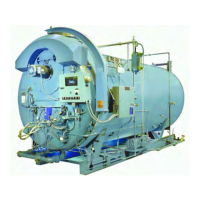Chapter 8 — Inspection and Maintenance
8-22 Part No. 750-184
Examine the condition of the burner housing and ensure that all necessary
burner setup is correct. Be sure the oil piping and atomizing air piping are
in good condition and not leaking, replace if necessary. Clean the cooling fins
on both the oil and atomizing air cooling tubes.
Using high temperature cement, fillet the corner of the dry oven to burner
housing contact area. Do not apply the cement more than 1/2 inch out from
the corner. Applying too much cement in this area could block the annulus
burner outlets.
Swing the front head in place. A long punch or prybar might be necessary
to align the bolt holes. Insert bolts hand tighten. After all bolts are threaded,
continue tightening in a star pattern.
After all bolts are threaded, continue tightening in a star pattern.
After all bolts are secured, tighten the upper and lower hinge nuts evenly to
pull the door securely against the vessel. Repeat the star tightening
sequence on the head bolts, to verify gasket sealing.
Do not overtighten. Tighten alternate bolts until the door is secured and gas
tight. After the boiler is back in operation, retighten the bolts to compensate
for any expansion.
Rear Door
The rear door is a steel shell containing a horizontal baffle and lined with
insulation material and castable refractory.
Burned or discolored paint on the outer surface of the door does not
necessarily indicate refractory trouble, but may be an indication of other
conditions, such as:
1. Leaking gaskets.
2. Improper seal.
3. Door retaining bolts insufficiently or unevenly tightened.
4. The air line to the rear sight tube may be blocked or loose.
5. Door was repainted with other than heat resistant paint.
Therefore, before assuming that the refractory requires reworking:
1. Check the condition of the tadpole gasket.
2. Check for cracks in the castable refractory.
3. Check the tightness of the door bolts.
4. See that the air line to the sight tube is clear, and that the connections
are tight. If necessary, blow the line clear with an air hose.
It is normal for refractories exposed to hot gases to develop thin “hairline”
cracks. It by no means indicates improper design or workmanship. Since
refractory materials expand and contract with changes in temperature, they
should be expected to show minor cracks due to contraction when examined
at low temperatures. Cracks to approximately 1/8" across may be expected
to close at high temperature. If there are any cracks that are relatively large
(1/8" to 1/4" in width), clean and fill them with high-temperature-bonding
mortar.
If the refractory or blanket insulation require replacement, contact your local
Cleaver-Brooks authorized representative.
Figure 8-1 Front Head, CB-LE
Gasket - dry oven
to front head
Gasket - front head
to tube sheet
Front head
Baffle, 2nd-3rd pass
Figure 8-2 Front Head, CB-OS
Gasket -
burner housing
to inner door
Gasket - dry oven
to inner door
Gasket - front head to inner door

